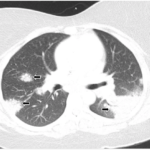I folded up the single page and placed it in my lab coat pocket.
Unexplained?
Browsing through my collection of fever of unknown origin articles, I noticed something I’d refused to acknowledge in my previous readings: In all of the FUO reviews, from Petersdorf and Beeson’s seminal article in 1961 through the most recent review of last year, for a small subset of patients, there simply is no explanation for their illness. Whether the patient is evaluated at the Massachusetts General Hospital, a community hospital in Maine, or Guys Hospital in London, anywhere from 5–15% of those afflicted by FUO remain an enigma.
On the other hand, I smiled to myself, maybe next time I see Mrs. N I’ll be on the receiving end of the genius effect. It works like this: A patient’s illness is a conundrum. Consultant after consultant is stumped. No one can figure it out—until the last doctor palpates, say, a swollen lymph node in the neck and performs a biopsy, confirming a diagnosis of Hodgkin’s disease. The patient believes the last doctor is a genius, never considering that the disease may have evolved and the lymph node is a new finding.
The very next day, Mrs. N was admitted to Maine Medical Center. A “spell” had settled over her while she and her husband visited friends on the peninsula in Portland. Midway through a pasta dinner, a flashing wave of fever, muscle aches and profound weakness took hold. She was so incapacitated, so overcome with the pain and drenching sweats, that she crumpled onto the couch, and her hosts called an ambulance. Mrs. N was whisked off to the ER, where she lacked the energy or conviction to refuse admission.
Up in Room 501, the fever broke, and the painkillers took hold. Mrs. N insisted she was well enough to walk to the bathroom. Her husband told her to stay in bed and press the call button for help. She ignored him and stood. He shuffled to her side, one hand on her shoulder, the other in the crook of her elbow. A quiet man, he was nearly overwhelmed by the sheer impossibility that there was no definitive explanation for her illness.
She inched slowly forward. “I’m so tired; the needlesticks, the urine and blood cultures, the scans. … It’s like a, a,” she searched for the right word. “It’s like that silly movie, Groundhog Day, telling my story over and over and over.”


